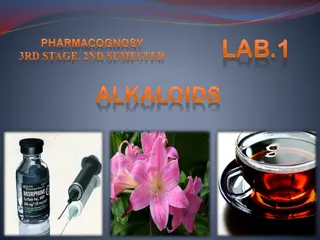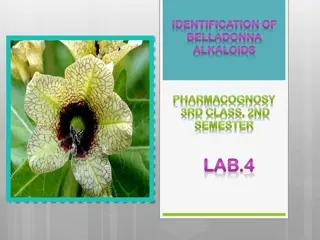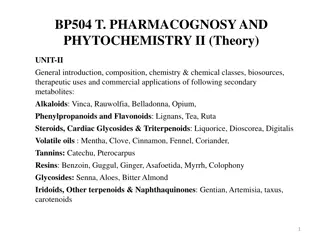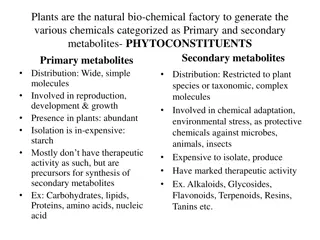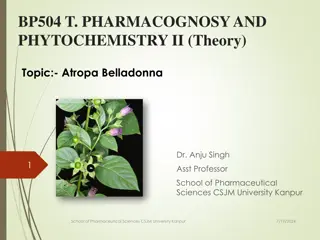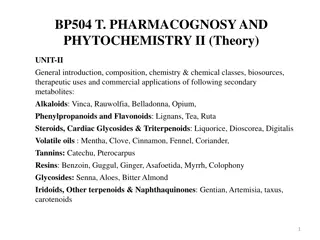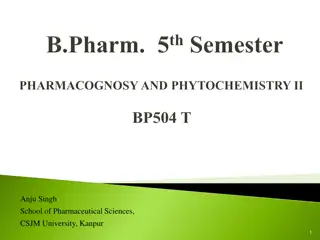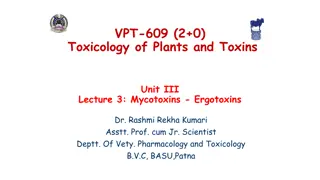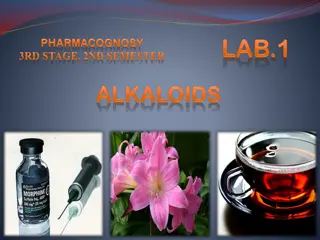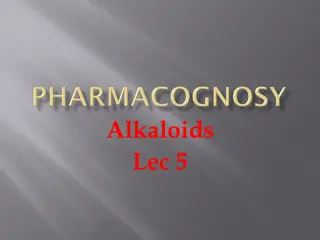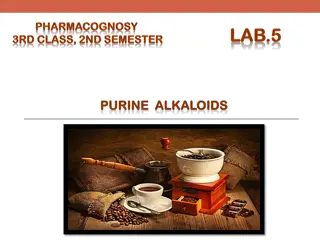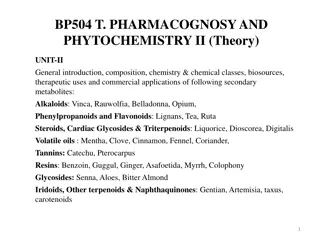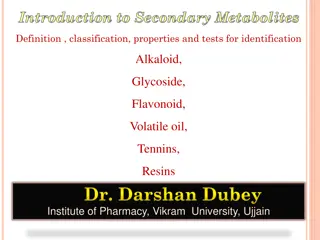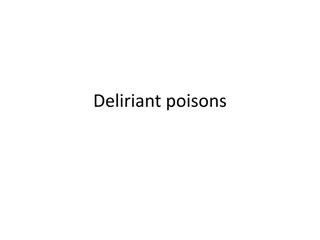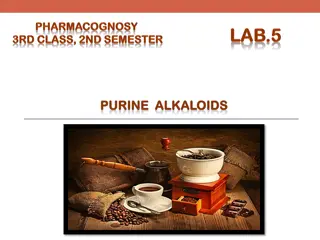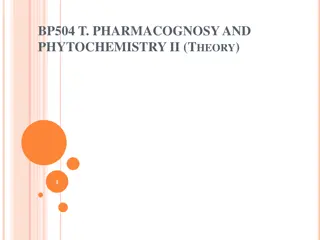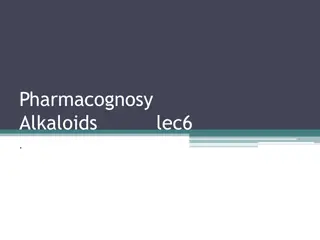Understanding Tropane Alkaloids in Datura Stramonium: Uses, Risks, and Chemistry
Datura stramonium, commonly known as Jimson weed, contains tropane alkaloids like atropine and scopolamine. These alkaloids have medicinal uses but can also be fatal if consumed in high amounts. The plant has been historically used for asthma relief and as a hallucinogen, but its toxicity can lead to severe side effects, including cardiac issues and neurological problems. Proper consultation and caution are crucial when dealing with datura due to its potent alkaloids.
Download Presentation

Please find below an Image/Link to download the presentation.
The content on the website is provided AS IS for your information and personal use only. It may not be sold, licensed, or shared on other websites without obtaining consent from the author. Download presentation by click this link. If you encounter any issues during the download, it is possible that the publisher has removed the file from their server.
E N D
Presentation Transcript
Tropane Alkaloids Lecturer Zena Qaragholi
] Tropane Alkaloids Datura stramonium, known by the common names Jimson weed or datura, is a plant in the Solanaceae (nightshade) family. For centuries, datura has been used as a herbal medicine to relieve asthma symptoms and as an analgesic during surgery or bone setting. It is also a powerful hallucinogen and deliriant, which is used spiritually for the intense visions it produces. However, the tropane alkaloids which are responsible for both the medicinal and hallucinogenic properties are fatally toxic in only slightly higher amounts than the medicinal dosage, and careless use often results in hospitalizations and deaths.
Constituents of datura are: Hyoscyamine and its isomer atropine, which is formed during extraction procedure. Also it contains hyoscine (scopolamine) alkaloid, which is found in trace amounts. The medicinal use is mostly due to the hyocsyamine (atropine), used as mydriatic, antispasmodic, antidote to the toxicity of cholinergic compound, decrease in the secretion (upper and lower respiratory tract) before surgery. While the use of scopolamine mostly in motion sickness. The tropane alkaloids (hyocsyamine and hyoscine) have the following structures:
Hyoscine (scopolamine) Hyoscyamine
These alkaloids are also present in other plants as Hyoscyamus niger of the family Solanaceae, Atropa belladona of the same family, and others.
side effects Datura side effects: Datura is a poisonous plant, so it should be taken only after consultation with experienced physicians. Datura chemicals such as scopolamine and atropine are used as poison and used in murders and suicides. Datura increases the heartbeat and may lead to cardiac arrest. Ingesting datura may cause violent behavior because of the presence of chemical substances called anticholinergic. Taking datura results in dilated pupils. One can also experience amnesia due to this. Blurred vision, nausea, giddiness, confusion, rapid pulse, hyperthermia are some of the side effects of datura. Datura can affect the nervous system adversely. The juice of datura leaves is also very harmful to the eyes.
Isolation and Identification of the Datura Alkaloids: Extraction: Aim: to isolate datura alkaloids. Equipments: Reflex apparatus. Conical flasks. Stirrer. Funnel. Separatory funnel. Water bath. Filter paper. Litmus paepr.
Reagents: 90% ethanol.??? 2% HCl.??? Ammonium hydroxide solution.??? Chloroform.
Extract 50 gm of the datura fruits in 150 ml of 90% ethanol under Reflex condenser for 1 hrs. Filtration Take 20 ml of alc. Extract in conical flask and concentrate on the water bath to about 2 ml to remove all of ethanol Pour the concentrated in to 10 ml of 2% HCl Heat gently (5 mins.) Cool and filter the Acidic extract and place in a separatory funnel [Wash with 5 ml of Chloroform] two times Take supernatant (upper layer) and made alkaline by addition of
Ammonium hydroxide solution (check by litmus paper) [Partition with 5 ml of Chloroform] two times Take the lower layer, dehydrate by adding anhydrous sod. Sulphate filter (or decant) , evaporate to dryness
1.Vitalli Marine Bu Test: Aim : to identify the tropane alkaloids from other alkaloids. Equipments and Reagents: Small beaker. Fuming nitric acid. Alcoholic KOH. 2. Results: Product containing the mixture of the alkaloids. The Identification of Datura Alkaloids: Qualitative Analysis: A.The specific tests for tropane alkaloids:
Procedure: Take few mls of the extract, add to it drops of fuming nitric acid and evaporate, then add 2 ml of alc. KOH. Result: A violet color will be developed.
2.Gerhard's Test: Aim: to identify the tropane alkaloids from other alkaloids. Equipments and Reagents: Small beaker. 2% HgCl2 in 50% aqueous ethanol. Procedure: Add 2% HgCl2 in 50% aqueous ethanol to 0.0006 g of atropine. Result : A deep red color will be developed.
Procedure: 1)Prepare 100ml of mobile phase, and place it in the glass tank. 2)Cover the tank with glass lid and allow standing for 45 minutes before use. 3)Apply the sample and the standard spots on the silica gel plates, on the base line by the use of capillary tube. 4)Put the silica gel plate in the glass tank and allow the mobile phase to rise to about two-third the plate. 5)Remove the plate from the tank, and allow drying, and then spray with the spraying reagent.
B.General tests for tropane alkaloids: All reagents used for tests of alkaloids could be applied on tropane alkaloids since they are true alkaloids. Identification of Datura Alkaloids By Chromatography: By the use of thin layer chromatography (T.L.C) The stationary phase = Silica gel G. The mobile phase = Butanone: Methanol: Ammonia (60:70:10) Or Acetone: Water: Ammonia (90:7:3). The standard compound = atropine or hyoscine. The spray reagent = Dragendorff's reagent. Mechanism of separation = Adsorption. Developing = Ascending. Other mobile phases : Chloroform: Acetone: Diethyl amine (50:40:10), Chloroform: Diethyl amine (90:10).
Study problems: Give the reason of : 1.Using the reflux in extraction the tropane alkaloid from datura stramonium. 2.Making the evaporation step after filteration? 3.Addition of 2% HCl to the alcoholic extract? 4.Addition of ammonium hydroxide? 5.Using of chloroform in partitioning step?
Procedure: Take few mls of the extract, add to it drops of fuming nitric acid and evaporate, then add 2 ml of alc. KOH. Result: A violet color will be developed. 2.Gerhard's Test: Aim: to identify the tropane alkaloids from other alkaloids. Equipments and Reagents: Small beaker. 2% HgCl2 in 50% aqueous ethanol.
Procedure: Add 2% HgCl2 in 50% aqueous ethanol to 0.0006 g of atropine. Result : A deep red color will be developed. B.General tests for tropane alkaloids: All reagents used for tests of alkaloids could be applied on tropane alkaloids since they are true alkaloids. Identification of Datura Alkaloids By Chromatography: By the use of thin layer chromatography (T.L.C) The stationary phase = Silica gel G. The mobile phase = Butanone: Methanol: Ammonia (60:70:10) Or Acetone: Water: Ammonia (90:7:3).
The standard compound = atropine or hyoscine. The spray reagent = Dragendorff's reagent. Mechanism of separation = Adsorption. Developing = Ascending. Other mobile phases : Chloroform: Acetone: Diethyl amine (50:40:10), Chloroform: Diethyl amine (90:10). Procedure: 1)Prepare 100ml of mobile phase, and place it in the glass tank. 2)Cover the tank with glass lid and allow standing for 45 minutes before use. 3)Apply the sample and the standard spots on the silica gel plates, on the base line by the use of capillary tube. 4)Put the silica gel plate in the glass tank and allow the mobile phase to rise to about two-third the plate. 5)Remove the plate from the tank, and allow drying, and then spray with the spraying reagent.


